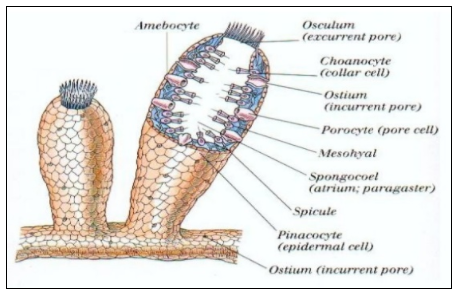
Sycon belongs to a group of animals which are best described as
a) Unicellular or acellular
b) Multicellular without any tissue organization
c) Multicellular with a gastrovascular system
d) Multicellular having tissue organization, but nobody cavity
Answer
497.4k+ views
Hint: Sycons are the sponges with the cellular level of body organization with numerous pores on their calceiform body and have canal systems. In Sycon each cell acts independently and shows very little coordination.
Complete answer:
Sycon belongs to phylum-Porifera (cellular sponges) and is the most primitive group of multicellular organisms. They belong to class Calcarea having spicules made of calcium carbonate in the form of calcite. They have a cellular level of organization where the cells do not form tissues and more or less work independently with very little coordination. Thus, Sycons are the multicellular sponges without any tissue organization.

Figure 1: Development of Sycon

Figure 2: Sycon cellular level of organization
Additional information
1)Though the cellular level of organization in Sycon shows the independent working of each cell with little coordination, there is some division of labor present among the cells, based on which the cells work independently performing only the function assigned to them.
2)Another important feature of Sycon includes the presence of the Canal system, formed from pores on the walls that penetrate into the body forming the water channels and spongocoel (the large central canal).
Therefore the correct answer ‘Multicellular without any tissue organization’.
Note: Sycon is a member of Porifera phylum known as pore bearers as their body is made up of body walls that possess many tiny pores (known as Ostia), giving it a sponge-like look. They exhibit cell aggregate body plan and thus are included in the sub-kingdom of Parazoa.
Complete answer:
Sycon belongs to phylum-Porifera (cellular sponges) and is the most primitive group of multicellular organisms. They belong to class Calcarea having spicules made of calcium carbonate in the form of calcite. They have a cellular level of organization where the cells do not form tissues and more or less work independently with very little coordination. Thus, Sycons are the multicellular sponges without any tissue organization.

Figure 1: Development of Sycon

Figure 2: Sycon cellular level of organization
Additional information
1)Though the cellular level of organization in Sycon shows the independent working of each cell with little coordination, there is some division of labor present among the cells, based on which the cells work independently performing only the function assigned to them.
2)Another important feature of Sycon includes the presence of the Canal system, formed from pores on the walls that penetrate into the body forming the water channels and spongocoel (the large central canal).
Therefore the correct answer ‘Multicellular without any tissue organization’.
Note: Sycon is a member of Porifera phylum known as pore bearers as their body is made up of body walls that possess many tiny pores (known as Ostia), giving it a sponge-like look. They exhibit cell aggregate body plan and thus are included in the sub-kingdom of Parazoa.
Recently Updated Pages
The correct geometry and hybridization for XeF4 are class 11 chemistry CBSE

Water softening by Clarks process uses ACalcium bicarbonate class 11 chemistry CBSE

With reference to graphite and diamond which of the class 11 chemistry CBSE

A certain household has consumed 250 units of energy class 11 physics CBSE

The lightest metal known is A beryllium B lithium C class 11 chemistry CBSE

What is the formula mass of the iodine molecule class 11 chemistry CBSE

Trending doubts
Arrange Water ethanol and phenol in increasing order class 11 chemistry CBSE

A mixture of o nitrophenol and p nitrophenol can be class 11 chemistry CBSE

Describe the effects of the Second World War class 11 social science CBSE

Which of the following methods is suitable for preventing class 11 chemistry CBSE

What organs are located on the left side of your body class 11 biology CBSE

The value of rate constant of a pseudo first order class 11 chemistry CBSE




